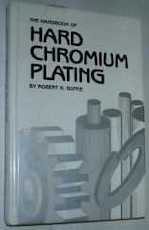
Curated with aloha by
Ted Mooney, P.E. RET

The authoritative public forum
for Metal Finishing 1989-2025

-----
How to test hard chrome without copper sulphate
Q. Sir,
We have been into the HCP of plastic extrusion die parts for the last 17 years. We have been using copper sulphate
⇦ this on
eBay or
Amazon [affil links] for checking the hard chrome plated surface where we cannot physically measure the thickness. Our customer requirement for HCP thickness is 10 to 40 microns. We have observed that repeated use of highly concentrated copper sulphate weakens the coating, and keeping the solution on the surface turns the HCP surface copper coloured. i.e., it erodes the coating. Not only does it erode the coating, it produces porosity in base material (which is ferrous steel -- EN8, EN19, etc).
Do we have any effective non-destructive test other than copper sulphate test, sir?
Plating shop Incharge - Vapi-India
July 19, 2021
⇩ Related postings, oldest first ⇩
Q. This is Sabir, Sr. Manager-Production/Kaizen, manufacturing Shock Absorbers/Struts for vehicles/motor cycles.
I am having a problem regarding Test of Hard Chrome Plating on SS Rods.
We are using copper sulphate (CuSO4) to apply on the plated surface. If the plating is insufficient, it removed away and substrate become naked with color of Copper (reddish shade) on the portion from where plating is wiped off on the rod.
However this process has become dangerous environmentally since ECHA List of SVHC under REACH Regulation has categorized "Copper sulphate" in list of Banned Material due to its Carcinogenic and Teratogenic effects on humans.
Please suggest some other way as Alternate solution to this efficient but dangerous process of Hard Chrome Plating Test by use of CuSO4 solution in water.
Agriauto Industries, manufacturing Shock Absorbers/Struts for vehicles/motor cycles. - Karachi,Sind,Pakistan
August 5, 2019
by Robert K. Guffie

on AbeBooks
(rarely)
or eBay
(rarely)
or Amazon
(affil links)
A. Hi cousin Syed. I hate to laugh at a question, but the irony can't possibly escape any reader that copper sulphate -- a chemical which is poured into drinking water reservoirs palette load after palette load, which is sprayed on crops around the world from airplanes, which countless millions of households pour down their toilets by the bucket to deter roots -- is a tool you are forbidden to use a medicine dropper full of to keep huge vats of hot, fuming, concentrated, toxic, carcinogenic, hexavalent chromium working correctly :-)
Several of our readers keep a close eye on REACH and similar standards and may be able to suggest whether your concern is real or a misunderstanding, and offer advise on alternatives if it is real.
Regards,

Ted Mooney, P.E. RET
Striving to live Aloha
finishing.com - Pine Beach, New Jersey
August 2019
|
|
A. Hi Syed, Aerospace - Yeovil, Somerset, UK August 16, 2019 Q. Hi, thanks for the response. Yes we are fighting against Chrome III considering it of the same notorious qualities. Our customers have also of the same opinion -- eliminate CrIII (CrVI). Agriauto Industries Limited, Shock Absorber manufacturing for vehicles/motor cycles - Karachi,Sind,Pakistan August 18, 2019 |
A. Hi Syed,
Not certain where you have got your information from, but under the current Classification, Labeling and Packaging for Supply (CLP) regulations, the EU adaptation of the Global Harmonised System of labeling (GHS), copper sulphate is classified as harmful if swallowed, irritating to eyes and dangerous for the aquatic environment. With a classification like this it is very unlikely to progress to the Candidate list of REACH, so will not make Annex XIV, nor is it likely to be restricted under Annex XVII.
However, as for other tests for adhesion, have you considered plating a test piece alongside you work and carrying out a bend test on it? The material of the test piece should be chemically similar to the material being plated. After plating, bend the test piece over a mandrel to 180 degrees and look for flaking on the bent area.
Depending on thickness of plating and your base material (needs to be a low alloy steel), you may consider a potassium_ferricyanide
[affil links] test. Potassium ferricyanide will turn blue with the underlying steel. It is a test often used to determine whether there is porosity in a coating.
Aerospace - Yeovil, Somerset, UK
August 21, 2019
![]() Following is the link from where I read and got alarmed about copper sulphate hazards:
Following is the link from where I read and got alarmed about copper sulphate hazards:
https://echa.europa.eu/substance-information/-/substanceinfo/100.028.952
At least I have removed the substance from uncontrolled use; and secondly the operator is restricted from using it to check Plating Quality on Line side Quality Gate station until CuSO4 replacement is available for production use in Plating check .
Thanks for the alternate solution. I will study/check/make trial for result confirmation to meet our purpose. However, ECHA doesn't seem to have much data about this chemical as mentioned in "Infoard" on below link:
https://echa.europa.eu/substance-information/-/substanceinfo/100.033.916
Anyway deeply grateful for your time, response and concern to my worry.
Agriauto Industries Limited, Shock Absorber manufacturing for vehicles/motor cycles - Karachi,Sind, Pakistan
August 23, 2019
A. Hi Syed,
What you've seen is the accumulated self-classification of copper sulphate. Not all manufacturers/importers classify it the same, however it does have a Classification and Labeling (C&L) classification, which is the official EU designation:
https://echa.europa.eu/information-on-chemicals/cl-inventory-database/-/discli/details/11545
for copper sulphate pentahydrate and the anhydrous version.
Aerospace - Yeovil, Somerset, UK
August 27, 2019
Q, A, or Comment on THIS thread -or- Start a NEW Thread